Pasubio
The Six First Rallies In The 1930s
1934 - First rally
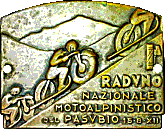
An accountant by profession, Giulio Ultimo Ziliotto was the man behind the creation and the organisation of the 'Raduno del Pasubio' and he did a remarkable job promoting this first meeting. Moreover, the patriotic ethos of the event in an era of blatant fascism easily won over the participation of local and provincial authorities.
Thus Marshal Guglielmo Pecori Giraldi, an Italian noble, general and politician, known primarily for his command of the Italian 1st Army during World War I, accepted the honorary presidency of the event. Commendatore Magnani, director of the magazine 'Motociclismo' at the time, also offered his patronage.
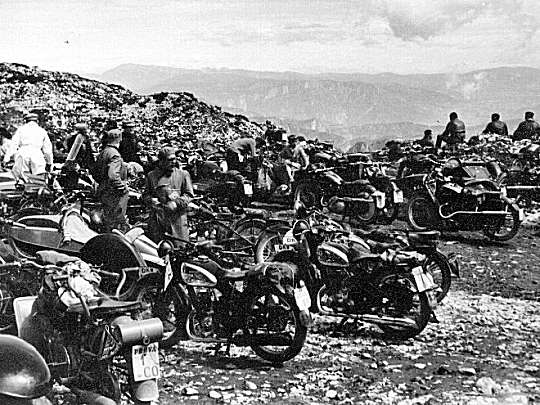
1934 - Participants and their machines at the very first Pasubio meeting
On this August 15, 1934, nearly 600 'centauri' from all over Italy gathered in the early morning to start the climb to the Pasubio.
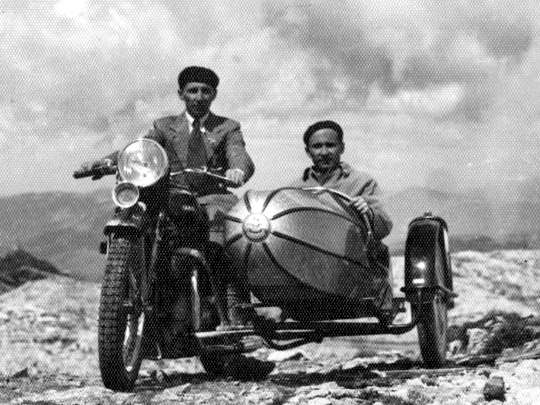
1934 - Two Italian 'centauri' pose for a souvenir photo. The berets they wore offered no protection in the event of a fall, but was back then in the 1930s much more fashionable. As for the outfit of the rider; suit, white shirt and tie worn in the summer heat of August; admirable...
Most of the famous Italian motorcycle clubs of the time: San Remo, Como, Trieste, Milan, Sestri, Vigevano, Cremona, Como, Latisana, Padua and Verona had responded to the call of MC Schio.
Military motorcyclists also joined their civilian counterparts, represented by soldiers from the Italian army.
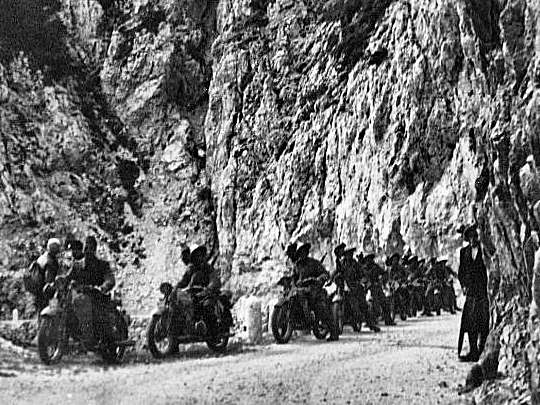
1934 - The military were also part of the event
On the ascension route, the organisers had set up two checkpoints.
The first was located at Passo Xomo at 1,058m, where the road to Scarubbi starts from the pass leading up to the Achille Papa refuge and passing through Bocchetta Campiglia at 1,216m, from where the road of 52 tunnels starts.
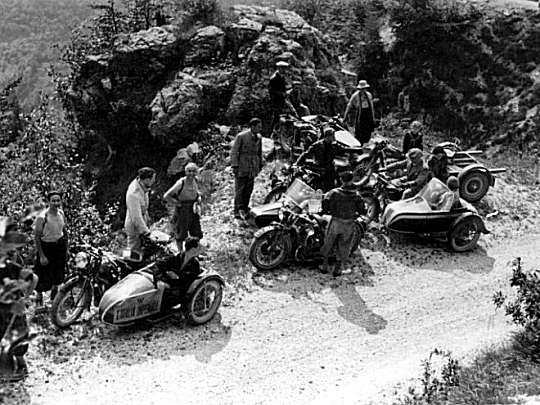
1934 - A small group of participants stop for a brief respite, letting the engines of their machines cool down
The second check point was located at Porte del Pasubio at 1,928m, a small saddle located between the main body of the massif and the contiguous Monte Forni Alti.
At 11am mass was celebrated in the old Cemetery of the Seven Crosses.
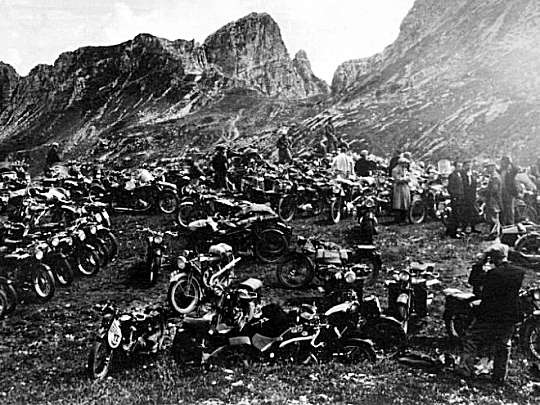
1934 - A view reminiscent of the Alpine gatherings of the 1970s such as the Chamois or the Stella Alpina
Back in Schio in the early afternoon, a colourful noisy tide of rallyists gathered to parade, waving their flags in front of the authorities. Then they gathered in the Piazza A. Rossi to listen to the official speeches and the greetings of the fascist authorities.
The noble and patriotic motives which fuelled this first meeting of August 1934 aroused a keen interest among government leaders, nobles and leading Italian industries. The resounding success of the rally nationwide led to the involvement of large numbers of people donating cups, trophies and other valuable items for the Pasubio meetings that followed.
1935 - the second rally

As such, the attendance at the second meeting in 1935 was boosted with almost 700 rallyists present.
The highlight of the second meeting was undoubtedly the inauguration and dedication, (together with the rally itself), of the Arco Romano, (the Roman Arch). This was a monument built in 1935 from Pasubio stone on the initiative of the Municipality of Schio and dedicated to the fallen in the Pasubian battlefield.

The Arco Romano
The Roman Arch was erected inside the perimeter wall that bounded the 'Di qui non si pass' cemetery, built during the war by the infantrymen of the Liguria Brigade. It superseded a previous monument built by soldiers on the peak at an altitude of 2035m, just above the ossuary gallery originally intended to be a resting place for human remains found from time to time.
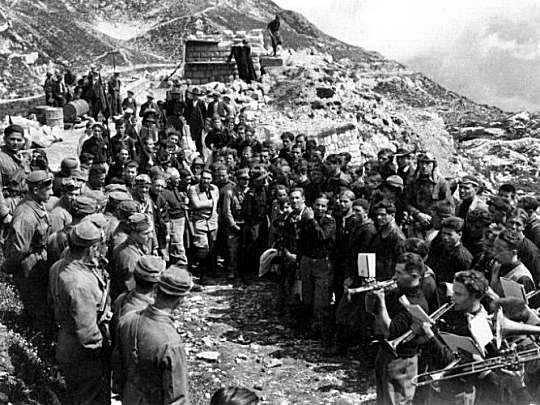
1935 - The inauguration ceremony
On 15 August 1935, on the occasion of the Pasubio rally, the Roman Arch was solemnly inaugurated in the presence of former combatants together with various military and civil authorities. Present at the time was the Italian Marshal Pecori Giraldi, commander of the First Army during the war.
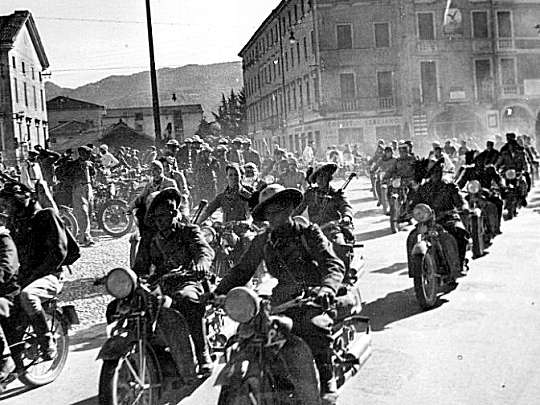
1935 - In town, military and civilian motorcyclists form a single troop of 'centauri' on their way to the ascent of Pasubio
Following this second meeting in 1935, a national resurgence followed and the Italian press covered the event extensively with glowing articles.
A feature article on the Pasubio rally was published on 22 August 1935 in the magazine 'Motociclismo' issue 34, calling the event "of the utmost patriotic importance and of remarkable motorcycling value."
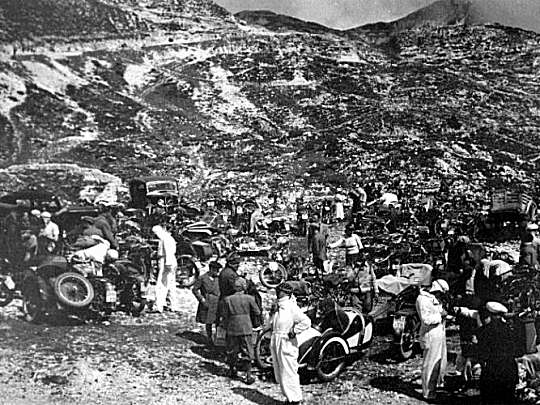
1935 - A view of the participants
A documentary by the Istituto Luce Cinecittà, shot at the second Pasubio gathering offered an excellent record of the event, allowing for the quality of images from that time.

1936 - The third rally
The 1936 rally, still under the leadership of U. Ziliotto, garnered no less than 900 motorcyclists who, once again, arrived from all over the country with the main objective of riding to the top of the sacred peak of Pasubio.
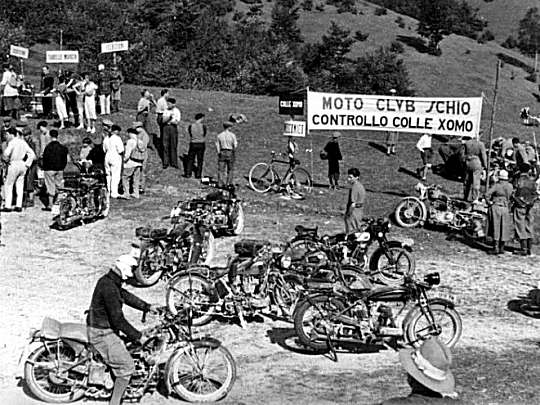
1936 - Rallyists at the first Passo Xomo checkpoint, 1,058m
In 1936 the organising club had begun offering participating rallyists a 'friendly competition'with prizes to be won.
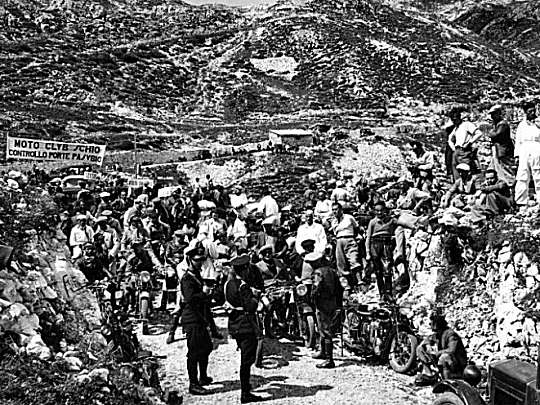
1936 - Rallyists at the second gate... Porte del Pasubio, 1,928m
This competition required riders to climb the Pasubio using alternative fuels with the tanks of the motorcycles taking part being sealed.
That year, another short film by the Istituto Luce Cinecittà was shot during the Pasubio rally, and perfectly reflects the atmosphere of the Schio motorcycle association's annual event:
1937 - the fourth rally
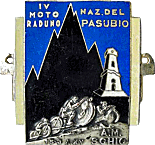
With the growing reputation of the Pasubio rally on the Italian motorcycle touring scene, in mid-August each year, more and more motorcyclists thronged to the province of Vicenza. So much so, that in 1937, for the first time, the number of those taking part exceeded 1000.
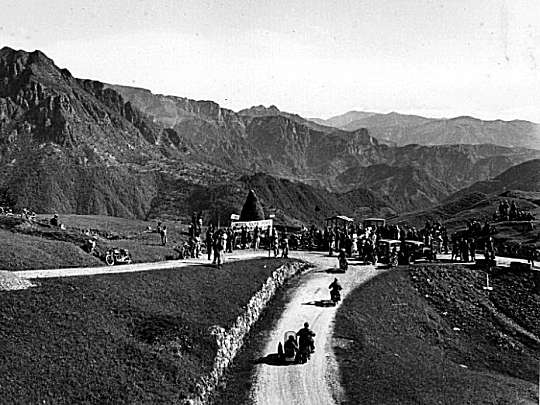
1937 - En route to the top
Fiat, the largest automobile manufacturer in Italy, together with some prominent personalities of the time such as Gian Galeazzo Ciano, 2nd Count of Cortellazzo and Buccari, offered the MC Schio splendid trophies for the 1937 meeting.
Gian Galeazzo Ciano was an Italian diplomat and politician serving as Foreign Minister in the government of his father-in-law, one Benito Mussolini... and widely seen as Mussolini's probable successor.
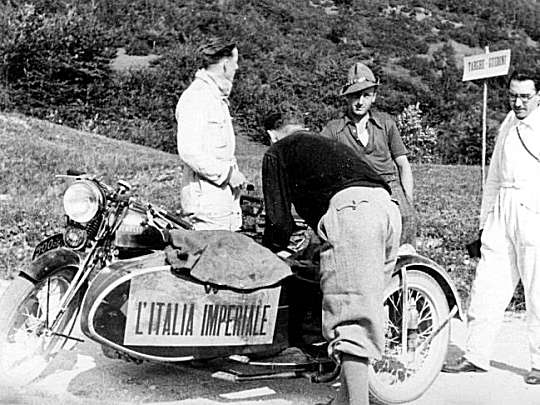
1937 - A combo owner proud to display his patriotism
Here is the film taken at the 1937 event. (Try watching at 0.75 speed.)
1938 - the fifth rally
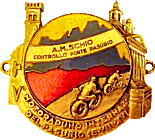
In 1938, the number of participants more than doubled to over 2,000. The grand assault on the summit of Pasubio undertaken on the mechanically rudimentary machines of the time.
This annual summer rally had now become one of the classics of the Italian rally calendar, a meeting that no self-respecting rally fan would want to miss.
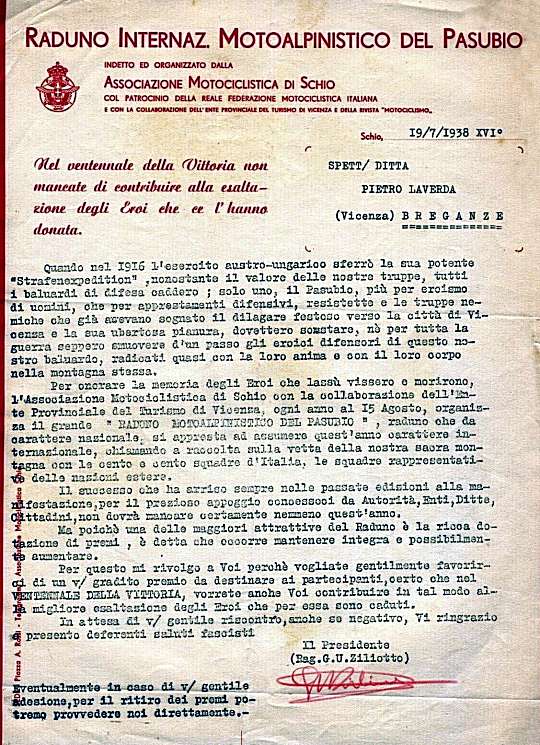
A rare document dated 19 July 1938: the letterhead of the rally presentation letter sent on by Giulio Ultimo Ziliotto, then president of the organising club of Schio, to Pietro Laverda Jr, the son of the founder of the famous motorcycle brand in Breganze
Contained in an article that appeared in issue 23 on 25 August 1938 in the magazine 'Motociclismo'; this quote says a lot about the fervour and patriotic pride associated with the Pasubio rally during this period of fascism in Italy:
With more than two thousand participants in the fifth meeting of Pasubio, we claim for Italian motorcyclists the great honour and the great merit of being, among sportsmen at the forefront of patriotism and at the avant-garde.
1938 - Participants posing for a souvenir photo
A film briefly sums up the 1938 meeting in pictures:
1939 - the sixth rally
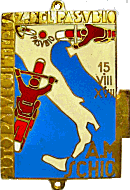
In 1939, this now international event reached the peak of its popularity and prestige with a gathering of no less than 2140 riders.
This year the awards ceremony was particularly richly endowed with a multitude of cups and trophies awarded to the most deserving.
Among these are two very valuable awards: the Great Silver Medal of HRH the Prince of Piedmont and the Great Cup offered by King Emperor Victor-Emmanuel III (1869-1947), King of Italy (1900-1946) Emperor of Ethiopia (1936-1943) and King of Albania (1939-1943).
It is very likely that at the time most of the participants had no idea that this was going to be the last meeting for a long while.

The 'Raduno Internazionale del Pasubio' disappearead from 1940 to 1949 until the Schio motorcycle club revived it in 1950
Like so many other sporting events of all kinds, the rally would indeed cease to exist for nearly a decade, when it was forced to close due to World War II.
The war also claimed the life of Giulio Ultimo Ziliotto, the man behind the creation and organisation of the Pasubio rally. He was killed at the untimely age of 38 during the massacre of Schio on the 7th July 1945.
Continued ...
- Jean-Francois Helias
Visit the Italian website www.motoradunidelpasubio.it/.